A closed pit where many died

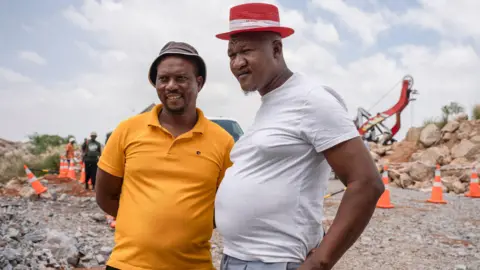 BBC
BBCWhen Mzwandile Mkwayi was lowered from a mine in South Africa into a red steel cage attached to a platform high above the ground, the first thing that hit him was the smell.
“Let me tell you something,” he told the BBC, “those bodies really smelled bad”.
When he got home that day, he told his wife not to eat the meat he cooked.
“It is because when I spoke to the miners they told me that some must eat others [people] inside the mine because there was no way they could get food. And they were eating cockroaches,” he said while calling from home.
Allegations that miners eat human flesh to survive, were also expressed by other miners who were rescued in December, in a statement sent to the high court.
Mkwai, a former convict in the area, known as Shasha, lives in Khuma township near the disused mine in Stilfontein. The 36-year-old suspect, who had served seven years in prison for robbery, volunteered to come down to help with rescue efforts.
“I was being rehabilitated by the correctional unit and volunteered because my people were looking for help for their children and brothers.
“The rescue company said they didn't have anyone who wanted to go down. So my friend Mandla and I agreed to volunteer to help our brothers get up and get the bodies out.”
But even though he wanted to help, the 25-minute walk down the 2km (1.2 mile)-deep shaft filled him with fear.
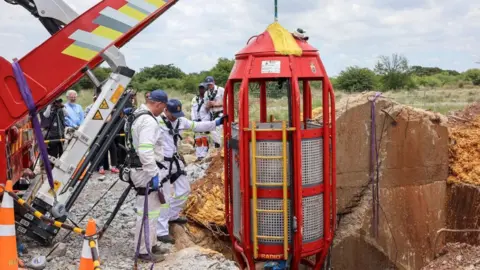 AFP
AFPThe crane would just stop and start, leaving him hanging in the dark. When he reached the bottom of the mine, he was shocked by what he saw.
“There were many bodies, more than 70 bodies, and about 200 people who were dehydrated.
“I felt very weak when I saw them, it was very painful to see them. But Mandla and I decided that we should be strong and not show them how we feel to encourage them.”
This story contains video that some people may find disturbing.
The miners who have been waiting for help for months, welcomed them with a hero.
He says: “They were very happy.
The miners were trapped there following a nationwide police campaign to crack down on illegal mining in abandoned areas they had closed, as the industry – once the backbone of the country's economy – declines.
It was no longer profitable for international miners to work in many areas, but the promise of gold deposits was a magnet for many desperate people – especially undocumented migrants.
Thousands of pits were left.
In November, the police stepped up efforts at the Buffelsfontein mine in Stilfontein, surrounding the entrance to the pit and refusing to let food and water down.
Before the rescue operation started on Monday, the local community tried to take matters into their own hands by lowering a rope down the canal to try to pull out some of the men.
They also sent messages telling the miners that help was coming.
“So when we arrived, they were already waiting for a crane. Now when they saw us, they saw us as their president, as their messiah: people from outside came to the pit to help them wake up.”
The police said that the illegal miners were always able to come out but refused because they were afraid of being arrested. But Mkwai denies: “It is a lie that people did not want to leave. Those people needed help, they were dying.”
While they were at the mine site on Tuesday, the BBC saw dozens of rescued men.
They looked thin, their bones showing through their clothes. Some were unable to walk and had to be assisted by medical staff.
In a statement submitted to the high court, the illegal miners described in vivid detail the slow and painful death of their peers. They say many died of hunger.
“From September to October 2024, the absence of even basic food was complete, and survival became a daily battle against hunger,” said one miner.
Mkwyi says the men he rescued were so weak that a rescue cage meant to hold seven healthy adults could only hold 13 of them.
“They were very dehydrated and lost weight so we were able to put a lot in the cage, because they wouldn't survive another two days down in the pit. They would have died if we didn't get them out quickly. .”
The volunteers were also in charge of removing the bodies.
“The rescuers gave us bags and told us to put the bodies in them and lift them up into the cage, which we did with the help of other miners.
The rescue operation was supposed to last at least a week, but after just three days, volunteers said no one was left underground.
Authorities sent a camera down for a final sweep. They say the mine is about to be closed forever.
But the experience affected Mkwyi a lot.
At one point during the call he asks her to repeat the question, explaining that her hearing has been affected since she went down the mine, possibly due to stress.
But the hardest impact was what he saw.
“I have to tell you that I was traumatized. I will never forget being seen by these people for the rest of my life.”
For activists and charity unions, the death of 87 people in the mine is tantamount to “massacre” by the authorities.
The use of an evocative word compare with the police shot dead 34 miners who were on strike in Marikanaabout 150 kilometers (93 miles) from Stilfontein, in 2012.
But this time no triggers are pulled. Instead, many men are seen starving to death.
The authorities reject their idea.
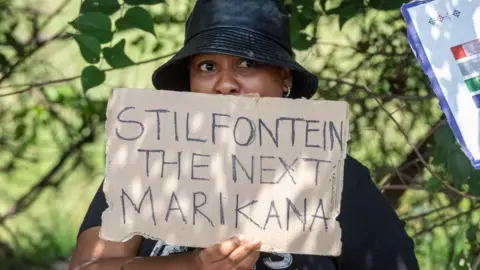 Getty Images
Getty ImagesThe government started a campaign to shut down illegal mining in December 2023 using Operation Vala Umgodi (which means “close the pit” in Zulu).
Abandoned mines were taken over by gangs, often led by former workers, who sold what was found on the black market.
People are put into this illegal trade, either by force or voluntarily, and are made to spend months digging underground. The government says illegal mining cost the South African economy $3.2bn (£2.6bn) in 2024 alone.
As part of the police operation, entrances to various abandoned mines were blocked, along with food and water, in an attempt to drive out the illegal miners, known locally as zama zamas (which translates as “take advantage”).
While Vala Umgodi was very successful in other provinces, the Buffelsfontein gold mine presented a unique challenge.
Before the police operation, most miners were able to go underground with a makeshift pulley system operated by people on the surface.
But they also left the hiding hole when the security officials came in large numbers in August, leaving those who were in the mine homeless.
Members of the public then stepped in to help, pulling a few people up using ropes, but this was a long, difficult process.
More difficult and dangerous exits were in place and there have been almost 2,000 re-exits – most of whom were arrested and are still in police custody.
Why some did not come out is not clear – they may have been too weak or they were threatened by members of the mine gangs – but they remained in dire straits.
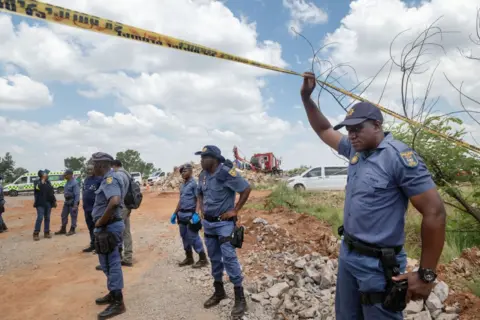 Getty Images
Getty ImagesOf the 87 dead, only two have been identified, the police said on Thursday, explaining that the fact that there are many undocumented immigrants made the process difficult.
“We are of the opinion that the government has blood on its hands,” Magnificent Mndebele of the Mining Affected Communities United in Action group (Macua), told the BBC.
He went on to say that the miners were not given a warning about what was going to happen before the police operation began.
For the past two months, Macua has been at the forefront of various courts that were launched to force the government to first allow the goods and start a rescue operation.
His accusations against the government are in line with previous statements by families who say the authorities killed their loved ones.
They had been fighting hard since the surgery went viral. In November, another minister, Mr. Khumbudzo Ntshavheni, made this infamous statement in a press conference that “they will smoke them”.
The government refused to allow food to be dropped or anyone who would help bring the miners back, agreed after many successful appeals in court.
In November, small portions of corn and water made it down the pit, but in a court statement one of the miners said it was not enough for the hundreds of men below, most of whom were so weak they could not even chew or swallow. see.
More food was brought in in December, but again it did not keep the men there.
Since the operation to remove the men and bodies took just three days, what is difficult for Mr. Mndebele is to understand why this was not done sooner, when it is clear that there is an issue.
“We are disappointed in our government, to be honest, because this help came too late.”
Although the government has not yet officially responded to these allegations, the police have vowed to continue with many campaigns to remove landmines that are no longer in use until May this year.
Speaking to journalists in Stilfontein on Tuesday, the Minister of Mines Gwede Mantashe was unapologetic. He said the government will strengthen the fight against illegal mining, calling it a crime and an “attack on the economy”.
On Thursday, Police Minister Senzo Mchunu said reconciliation was slow.
“I understand and accept that this is an emotional issue. Everyone wants to judge… but it would help us all as South Africans to wait until the pathologists finish their work,” he said.
The police defended their action, saying that giving the miners food would have allowed crime to flourish.
Illegal miners are accused of promoting crime in the communities in which they operate.
There are many stories published in the local media linking the attempted rapes and various murders.
But for Mkwayi, who put his safety on the line to help the miners, the men in the Stilfontein mine were just trying to make ends meet.
“People went down a rope for 2km and risked their lives to put food on the table for their families.”
He said he wants the government to grant licenses to miners who are forced to enter mines that are no longer in use due to the high unemployment rate in South Africa.
“If your children are hungry, you won't think twice about going down there because you have to feed them. You will risk your life to put food on the table.”
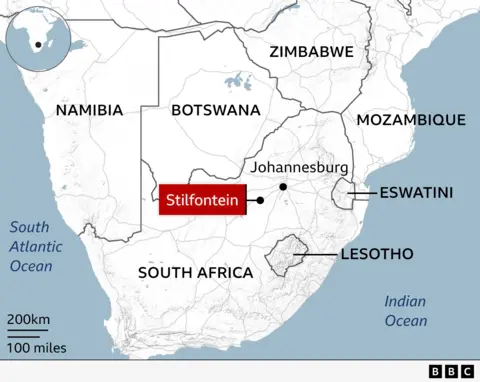
You may also be interested in:
 Getty Images/BBC
Getty Images/BBCSource link


